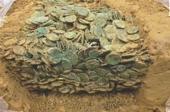By Mark Fox, World Coin News | July 24, 2012 | NUMISMASTER.COM
This article was originally printed in World Coin News.
Celtic Treasure Unearthed in Jersey
This past June the largest Celtic coin hoard on record, containing an estimated 50,000 coins, was carefully lifted with a crane from its circa 2,050-year-old hiding place beneath a farmer’s corn field in the eastern part of Jersey. As the largest member of the Channel Islands, Jersey has been a dependency of the English Crown since the Middle Ages. It lies nestled with the other islands off the west coast of Normandy in the English Channel.
Celtic coin researcher Dr. Philip de Jersey, the chief archaeologist of Jersey’s Channel Island neighbor Guernsey, was one of those invited to help excavate the treasure. During the course of the dig, De Jersey noted that “it soon became apparent that the hoard was potentially much larger than anybody had anticipated.”
Even now, archaeologists are not quite certain what exactly lies within the 750 kg (about three-quarters of a ton) clay block that contains the hoard, now being scrutinized and slowly picked apart at Jersey Archives in St. Helier. So far the only coins they have seen in the solid mass are billon staters and quarter staters of the Coriosolites, a Celtic tribe that hailed from Armorica (modern-day Brittany and Normandy), inhabiting roughly what is today the French department of Côtes-d’Armor. De Jersey estimated that each coin, sold individually, could fetch between 100 and 200 pounds (about $155–$310).
If all the coins turn out to be solely Coriosolite types with no major surprises, they may raise several million dollars sold en bloc, but certainly less than the often quoted $10 million. For veteran Jersey metal detectorists Reg Mead, 70, and Richard Miles, 49, one thing is certain: A quest of 30 years has finally ended in success.
A Long Search
This story begins with a story told to Mead by the daughter of a local Jersey farmer about 30 years ago. She recounted how her father had accidentally uncovered a hoard of silver coins during the 1950s while removing a tree in a hedgerow in the parish of Grouville. The clay pot that the coins were in shattered in the process and the contents were violently scattered. A small potato sack was filled with the coins and possibly given to the local mayor while the rest of the find was plowed under. A description of the silver pieces convinced Miles and Mead that they were most likely minted by Brittany Celts, but the woman had only a general idea of where the hoard was discovered.
“[Reg Mead] often talked about it,” recalled Miles to this writer. “And over the years we gained permission to search a number of the fields in the area. We didn’t find anything to confirm the story, but it was clear from other objects (pottery, worked late Neolithic/Bronze Age flint tools, etc.) that there had been early activity in the vicinity.”
It was a slow process. In fact, it was not until early this year when Mead and Miles were first allowed to hunt in the particular field that they believed the farmer’s daughter had spoken of. “After one initial search proved negative,” Miles explained, “I conducted some research using current satellite maps, together with an early map of the island (the 1795 Duke of Richmond map) and later ordinance survey maps, to work out how field boundaries had changed over the years. Using this info I plotted a course that I thought may take me in the direction of the find spot. On Friday 20th, January 2012, I found the first coin.”
This first coin was quickly followed by many others. By Jan. 25, the tally was 61. De Jersey remembered when Mead and Miles excitedly showed him their finds.
“The coins intrigued me: as well as the expected Armorican issues, produced in Brittany and Normandy, there were coins from further afield in Gaul, and a few Roman bronzes too. Reg and Richard were convinced that they had found coins scattered from the hoard which their research had suggested lay hidden in this field. I was less sure: the range of types was unusual, and the Roman coins certainly didn’t originate in an Iron Age hoard.”
The number of coins increased still further, to about 100 by the time operations were halted by the planting of Jersey Royal potatoes at the end of February. But the duo was back in mid-May and found approximately 25 more coins. On May 29, they brought with them a special deep-seeking metal detector – Mead’s pride and joy – in the hopes of finding the bottom of the original container, which they thought might still be partially intact and filled with coins at, or below, the plow zone.
After searching for only 20 minutes in the same area where the coins were concentrated, Mead hit a deep target. About 40 minutes of digging to a depth of a meter satisfied their pains. Mead summed up this intense moment to the press: “We hit something hard. We just put the shovel in here and moved it. We hear that grinding noise of metal rubbing against metal. Just flicked and out came five Iron Age coins. You just go numb. You say: isn’t that lovely? And it’s a very quiet feeling, isn’t it? Wow.”
They immediately stopped digging, buried the hole, and reported their discovery to Olga Finch, curator of archaeology at Jersey Heritage. With the landowner’s consent, an excavation was quickly started in June. It was conducted by the Jersey Heritage Trust, the Société Jersiaise, de Jersey, the two finders and members of their families, plus “a few selected others sworn to secrecy.”
Knowledge of the exact find spot is still off limits to the public. It will likely be for some time as the area, now currently protected as an “Area of Archaeological Potential,” undergoes further excavations.
A Case of Jittery Celts?
Over the centuries, quite a few hoards of predominantly Coriosolite coins have been unearthed in Normandy and on Jersey. Until now, the largest recorded hoard of Coriosolite coins was La Marquanderie, a huge stash containing almost 12,000 silver pieces, discovered in 1935 in the parish of St. Brelade, Jersey.
Celtic coin expert and dealer Chris Rudd is of the belief in his CoinsWeekly online article, “Jersey – the Treasure Island of Celtic Coins,” that most “staters of the Coriosolites were struck during the Gallic War to finance resistance to the savage invasion of Julius Caesar. Why else would so many staters have been minted around this time?”
During Caesar’s campaigns to subdue Gaul in the ’50s B.C.E., the Celtic world in the West was turned upside-down. In their haste to flee the advancing legions, it is easy to imagine that a lot of Celts would have buried whatever nonperishable wealth they couldn’t take with them.
The picture of the Grouville hoard, however, is surprisingly complex. The clay block holding the hoard also contains objects other than coins. So far seen is at least one piece of silver jewelry, a “piece of crumpled gold,” and a possible gold torque, which the other gold item might also be. Although archaeological reports are expected in due course, Miles thinks the old hedgerow hoard was likely a different cache, buried close to, or even above, the main hoard.
Finders Keepers or Just Finders?
As of this writing, no one is quite certain who actually owns the Grouville hoard. It so happens that the Treasure Act 1996, which had replaced the medieval Treasure Trove law in England, Wales, and Northern Ireland on Sept. 24, 1997, does not apply to Jersey. However, the old law does, or at least did. There is speculation that it may now be obsolete.
“Under this law,” explained De Jersey. “The hoard would almost certainly belong to the Crown, and the finders (and landowner) would share the reward. The finders, or at least one of the finders, Reg Mead, is keen to get the new Treasure Act in place in Jersey and seems to believe that this might be the spur to do so.”
Implementation of the Act would define a greater number of objects as “treasure,” not merely those of gold and silver, and simplify the task of the coroners, whose job it is to prove whether or not a find is treasure. According to the text of the Act, there is no longer “the need to establish that objects were hidden with the intention of being recovered.”
Whatever the legal outcome, Mead and Miles can at least hope for some sort of remuneration for their commendable service. How large it will be remains to be seen, although neither finder is too keen to receive millions of Jersey pounds. As Mead told Jane Fryer of Mail Online, “I don’t want to go round the world and I don’t want a new car: besides, if I came home from detecting with a new car covered in mud, Ruth would go mad.”




